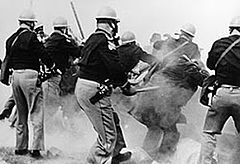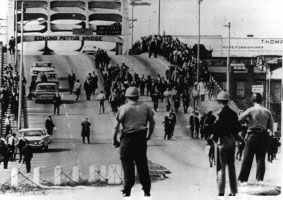User:Mur530/sandbox
| Williams v. Wallace | |
|---|---|
 | |
| Court | United States District Court, Middle District of Alabama |
| Full case name | Hosea WILLIAMS, John Lewis and Amelia Boynton, on behalf of themselves and others similarly situated, Plaintiffs, United States of America, Plaintiff-Intervenor, v. Honorable George C. WALLACE, as Governor of the State of Alabama, Al Lingo, as Director of Public Safety for the State of Alabama, and James G. Clark, as Sheriff of Dallas County, Alabama, Defendants. |
| Decided | March 19 1965 |
| Citation(s) | 240 F. Supp. 100 |
| Holding | |
| Preliminary Injunction granted against the defendants, with a restringing order issued preventing the defendants from arresting or harassing or threatening the marchers and obstructing the peaceful nonviolent protest for the days scheduled. | |
| Court membership | |
| Judge(s) sitting | Hon. Frank Minis Johnson |
Williams v. Wallace, 240 F. Supp. 100, was a legal case heard before Judge Frank Minis Johnson of the United States District Court for the Middle District of Alabama on March 19, 1965. The ruling came during the Selma to Montgomery marches after two unsuccessful attempts by the plaintiffs, which included Rev. Dr. Martin Luther King, Jr. and members of the Southern Christian Leadership Conference (SCLC), the Student Nonviolent Coordinating Committee, (SNCC), and the Dallas County Voters League (DCVL) and countless sympathizers from around the country, to form a peaceful, nonviolent protest march between Selma, Alabama and Montgomery, Alabama. The case was brought against then-Governor of Alabama George Wallace, then-Director of Public Safety for the State of Alabama Al Lingo and then-Sheriff of Dallas County Jim Clark. The court ultimately ruled in favor of the plaintiffs, granting a temporary injunction barring the governor or the state and local authorities from interfering with the protestors in any way allowing the march to complete unimpeded between March 21 and March 25 from Selma to Montgomery.
Background[edit]
Members of the Southern Christian Leadership Conference, headed by Dr. Martin Luther King, Jr., were summoned to Montgomery by the Dallas County Voters League, after continuous failed attempts by the African-American residents to register to vote. The Dallas County Voters League and the Student Nonviolent Coordinating Committee had maintained for several years prior a voter registration drive for the black citizens of Selma, Alabama. However, these attempts were continuously impeded by the local, county, and state authorities eventually leading up to Governor George C. Wallace to prevent the applications from being approved, including poll taxes, extensive questionnaires, and the identities of voter registration applicants being made public in local newspapers. Since the Civil Rights Act of 1964 had been signed into law by President Lyndon Johnson the previous year, segregation had been outlawed nationwide, although several southern states, including Alabama, continued to uphold Jim Crow legislation preventing people of color from successfully registering to vote.
On February 18, 1965, during a march in Marion, Alabama led by C. T. Vivian to protest the arrest of James Orange, the marchers were attacked by a group of Alabama state troopers. When Jimmie Lee Jackson, a marcher, fled with his mother and hid in a nearby café, several state troopers followed them and proceeded to beat Jackson and his mother until Cpl. James Bonard Fowler shot Jackson in the chest. He was pronounced dead eight days later. Jackson's death would be used as a symbol of police brutality towards African Americans in the south, especially during the fight for equal voting rights.
Dr. King and his associates began planning and organizing a march from Selma to Montgomery in order to protest the unfair practices of the City of Montgomery, Dallas County, and the State of Alabama to prevent African Americans from registering to vote.
The First March[edit]

The first march commenced on March 7, 1965 one what henceforth would be known as Bloody Sunday. As the marchers, led by Rev. Hosea Williams of SCLC and John Lewis of SNCC, crossed the Edmund Pettus Bridge, they were met by led by Officer John Cloud and a small army of state and local police, both on foot and on horseback, armed with batons, guns, and tear gas, blocking the marchers from continuing down U.S. Route 80. Cloud announced that the marchers had two minutes to disperse, but when Rev. Williams attempted to speak to him, Cloud ordered the officers to advance, beginning a full assault on the peaceful protestors in front of a number of news reporters and photographers. Tear gas was first to try and conceal some of the brutal assault, which included women and the elderly.
The Second March[edit]

After word of Bloody Sunday reached around the United States, thousands of people, including religious leaders, white sympathizers, and others flooded into Selma to take part in the next march. The SCLC attempted to obtain an order of protection from the court against the police to prevent them from interfering. Judge Frank Minis Johnson issued a temporary restraining order on the marchers, preventing the march from taking place until a hearing could be held later in the week. Johnson, who in the past had demonstrated to be one of the few southern judges to sympathize with the Civil Rights cause, planned to give the defense, which consisted of Governor Wallace and state and local police, time to prepare.
Given the amount of individuals who trekked to Selma expecting to march, the SCLC was determined to proceed and defy the court's restraining order, even though they knew the risk of being charged with contempt of court. "Turnaround Tuesday," as it came to be known, commenced on March 9. The marchers, this time led by Dr. King, proceeded once again across Edmund Pettus Bridge. Once again, there were state and local police blocking the foot of the bridge. As the marchers reached the middle of the bridge, Dr. King suddenly stopped which prompted the rest of the group to stop. The marchers then kneeled in prayer before getting up, turning around, and proceeding back into Selma thereby complying with Judge Johnson's restraining order not to complete the march.
Following the march, three white ministers who were in town to support the march were walking through Selma when they were met by a small group of Klansmen and brutally beaten. Among the ministers was Rev. James Reeb, a white Unitarian Universalist minister from Boston, who was the most severely injured. Selma's public hospital refused to treat him due to his association with the black population, thereby delaying treatment and ultimately causing his death two days later.
Case[edit]
ceioheroihvoerv
Response[edit]
In Popular Culture[edit]
The case Williams v. Wallace was portrayed in the 2014 film Selma, with Judge Johnson portrayed by Martin Sheen.

